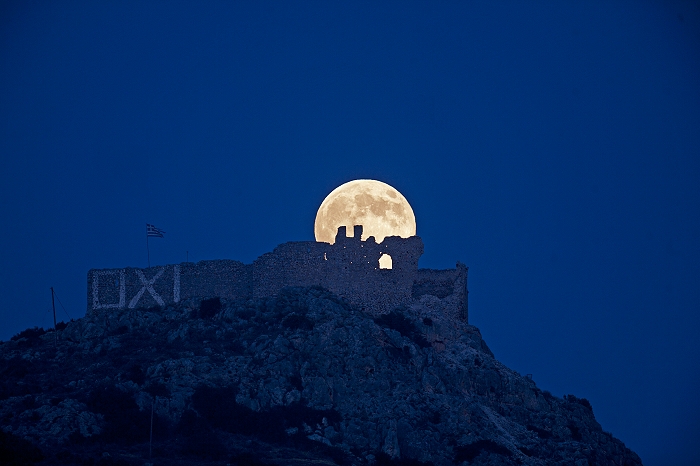
Our closest celestial neighbour has kept us company for at least four billion years and has entertained our imagination in a variety of
ways. It certainly has been involved in our maturation as a species with man's first step on a body beyond our planet during the latter
part of the twentienth century and will, inevitably, be our first stop prior to any sort of manned travel to a further celestial body
such as Mars. The moon has been a great source of education about our own planet's evolutionary history; it has entertained many
inquisitive minds from earlier cultures and generations about the universe in general and man's role in particular; it has enriched the
minds of young children taking their first look through a telescope and continues to impact our lives in ways we may or may not readily
recognize including tidal forces and various natural rhythms and cycles.
Note: The image below is a follow-up to other similar efforts involving the rising (full) moon near dusk and
against well-known landmarks in Greece including archaeological grounds (see
here). Such an exercise requires careful planning and execution
so that the azimuth and altitude of the rising moon match precisely with the foreground landmark of interest. Also important is the time during
late afternoon that such an attempt is executed, for one requires balanced lighting between the foreground landmark and the bright rising
(full) moon. Once all of these factors are available simultaneously with respect to lighting balance (full moon and landmark foreground) as
well as azimuth and altitude, a result such as the one below involving the 13th century Byzantine Castle Fyllon is realized.
One of the many castles which characterize Greece's second largest island, Euvoia, is
the medieval Castle Fyllon (Κάστρο Φύλλων) lying atop a hill 160 meters above ground level and to the east of the small
town Fyllon which sits at the base of the same hill. Also known as Castle Kastelli and Castle Likario, the castle was
built by the Venetians in the 13th century AD and is widely associated with the Venetian knight Licario who sought and
virtually managed to conquer all of Euvoia on behalf of Michael VIII Palaiologos (1223-1282), Byzantine Emperor of the
time (1259-1282), as vindication against the family Carceri who lived on the central portion of the island and who
despised him for secretly marrying their daughter. Following the completion of his final military campaign in Euvoia
and upon his consequent return from Constantinople, he ultimately chose the castle lying atop the 160-meter tall hill
Fyllon as his home and where he remained until the end of his life. His death is shrouded with some mystery and, according
to legend, he was poisoned by his beautiful lover from Chalkida, Euvoia. When the island of Euvoia was later invaded
by the Ottomans, two of the walls of Castle Fyllon were purposely destroyed so as to render the castle useless. It has
remained in this form to this day with the northern and eastern sides totally obliterated.
Note: For additional photos of the rising moon from the same session as well as photos of the sun and/or full moon
against other well-known Greek archaeological grounds and sites, please click
here.
|
Body: Moon Mass: 0.0123 x Earth Mean Eq Diameter: 0.2719 x Earth Distance: 356,896 km Sidereal Rev: 27d 07h 43m 11s Age: 14d 17h 44m Phase: 99.8° Diameter: 33.56' Magnitude: -12.6 Rukl: N/A |
 |
Date: Aug 10, 2014 Location: Fylla, Euvoia, Greece Equipment: Takahashi FSQ 106/f5 Canon EOS 5D Mark I Baader UV/IR-Cut Filter Exposure: 1 x 1/30 sec ISO 100 RAW Image Format 4368x2912 image size Manual Mode Servo Mode Software: Digital Photo Pro V2.1.1.4 Photoshop CS5 Processing: Resampling JPG Compression |